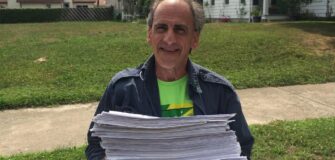A review of The Story of Stuff by Annie Leonard
Share
by Wendy Kenin, Green Party of California
Book + Videos with Green messages reaches millions
 After learning about the success of the Story of Stuff 20-minute video, which has reached over 10,000,000 viewers in over 200 countries, I thought, ìThe Green Party should seriously look at how Annie Leonardís green message was able to reach to so many.î Leonard has illuminated in some of the farthest corners of the Earth the entangled elements of irresponsible governments and corporations that are exploiting and abusing societies, cultures, economies, and the environment.
After learning about the success of the Story of Stuff 20-minute video, which has reached over 10,000,000 viewers in over 200 countries, I thought, ìThe Green Party should seriously look at how Annie Leonardís green message was able to reach to so many.î Leonard has illuminated in some of the farthest corners of the Earth the entangled elements of irresponsible governments and corporations that are exploiting and abusing societies, cultures, economies, and the environment.
Now offered in 11 languages on The Story of Stuff Project’s international website, the video has been opening minds since its release in 2007. Since the time her video came out, Leonard has made more films, The Story of Cap ‘n’ Trade (over 600,000 views) and The Story of Bottled Water. The Story of Cosmetics is her July 2010 Release. Her next film The Story of Electronics is due out in the fall of 2010.
Annie Leonard released her book The Story of Stuff: How our obsession with stuff is trashing the planet, our communities, and our health – and a vision for change in March 2010. She uses this new platform to delve further into flaws of the materials economy, calling out “unmentionable” capitalism in its current form as unsustainable, asserting that it is patriotic to examine our failed economic system.
“Our Project is systems-focused, solutions-oriented and change-driven,” the Story of Stuff Project website states. Coming out of the depressing truth of a massive system out of control, the book is speckled with signs of hope and viable alternatives. She transmits a sense of consumer empowerment and responsibility by providing links to resources, and laying out the options and outcomes of our everyday choices.
As in her video, Leonard gives more examples of power imbalance, with such specifics about how the world’s wealthiest nations are dumping toxic waste on the world’s poorest countries. In her video, Leonard presents her case with chapters on: extraction, production, distribution, consumption, disposal, and “another way.” Also her blog contains a categories section on materials economy. Her book chapters are arranged the same way, unfolding deeper facts that clarify the framework with more illustrations to help you feel the reality of this burdensome system.
Presentation
 The introduction to the book opens with author Annie Leonard’s personal story, growing up in Seattle, Washington, the evolution of her personal interests, and the context for the story of stuff – including the bold assertion we are nearing limits, ideas about interconnectedness and solutions, and statements of intention. One signature cartoon appearing in the introduction is the “work-watch-spend treadmill”, which in the video Leonard narrates with a spoken-word depiction of life in America:
The introduction to the book opens with author Annie Leonard’s personal story, growing up in Seattle, Washington, the evolution of her personal interests, and the context for the story of stuff – including the bold assertion we are nearing limits, ideas about interconnectedness and solutions, and statements of intention. One signature cartoon appearing in the introduction is the “work-watch-spend treadmill”, which in the video Leonard narrates with a spoken-word depiction of life in America:
“So we are in this ridiculous situation where we go to work, maybe two jobs even, and we come home and weíre exhausted so we plop down on our new couch and watch TV and the commercials tell us ìYOU SUCKî so gotta go to the mall to buy something to feel better, then we gotta go to work more to pay for the stuff we just bought so we come home and weíre more tired so you sit down and watch more T.V. and it tells you to go to the mall again and weíre on this crazy work-watch-spend treadmill and we could just stop.”
The Story of Stuff Project channel on youtube features a banner with cartoon stick characters holding signs at a demonstration such as: “Green Jobs Now,” ” Justice,” “Yes We Can,” “Si Se Puede,” and “More Fun Less Stuff!” Leonard’s brand from the web and videos carries over to the book, as you can hear her upbeat voice in the text and enjoy eye-opening graphic depictions of straightforward facts and statistics.
The extraction chapter sections are broken into trees, water, and rocks, with subsections such as: gold, diamonds, other conflict minerals, coal and petroleum. Leonard also rethinks extraction, the imbalanced benefits, and how to transform extraction.
Production involves lists of hazardous materials, toxic pollutants and identification of exposure pathways, plus a history of industrialization, which is also communicated in a page of charts in the book’s introduction. These charts demonstrate the coinciding rise in water use, paper consumption, population, motor vehicles, global biodiversity loss, ecosystems, and surface temperature of the earth.
We learn about dangerous working conditions and environmental racism, about mismanaged governmental structures implementing inconsistent standards. We also find out that PVC plastic and aluminum cans are the stupidest inventions still in use.
In the chapter on distribution, Leonard describes the history of international financial institutions, and the devastating impacts of the IMF (International Monetary Fund), World Bank, NAFTA, GATT, and the WTO (World Trade Organization). “There is no way to comprehend the story of Stuff with out them because they establish the rules…”
Of strategic benefit for the 20-something activists and young adults who were kids when it took place, Leonard proceeds to recount the history of the 1999 international 70,000 person-strong protests at the WTO in Seattle. At the time, she says the WTO had grown into “an international regime that prioritizes trade over the planet, communities, and workers.”
The consumption chapter demonstrates that Americans are unhappy, due to messages from the media and deteriorating social relationships caused by the need to spend time interacting around consuming and maintaining Stuff. Americans are spending more time at work than people in any other country, and we’re less happy. Corporate messaging and governmental sanctification of consumerism are replacing the wisdom of our spiritual ancestries. The materials ritual is the act of buying more than our share of Stuff.
We learn from the chapter on disposal: types of waste, various methods for sending Stuff ‘away’, the huge amount of industrial waste, and how much more than ever before we have of waste. We learn about wealthy nations dumping on the third world, related disparities, and some illuminating grassroots and international victories. Leonard points to zero-waste initiatives, including comprehensive approaches to reduction, reuse, composting, and some recycling, as leading solutions to our disposal problems.
Activism
With an attitude, she relays the history of resistance, provides contacts and resources, and shows a vision for positive solutions. Leonard works hard to motivate the reader to contribute to positive change, and presents arguments to convince you to “reactivate your inner citizen.”
Leonard describes fragmented justice movements and urges people to make the connections, unite, and “take back” our governments, to rebuild society based on sustainability and equity. A glossary of terms in the book would be helpful, despite the fact that The Story of Stuff website is designed to be fully-interactive, with opportunities even throughout the video to click and learn more and connect with organizations working to make change.
Also in the book, I found myself wanting a condensed list of action resources, which are instead spread throughout the book such as www.waterfootprint.org, http://www.goodguide.com/ to check up on consumer products, and http://citizen.org/trade/tradeact/ on international trade.
Leonard takes the time to share stories of desperation and even martyrdom as fallouts to global industrialism – from the deaths and injuries of thousands of people caused by U.S. multinational Union Carbide Corporation’s chemical leak in Bhopal, India in 1984, to the story of Nigerian activist Ken Saro-Wiwa who was executed in 1995 with eight other activists during a campaign to expose and end Shell Petroleum’s theft and pollution of Ogoni people’s land and resources – emphasizing “the intersection of environmental, human rights, and economic abuses.”
ìWe come home and weíre exhausted so we plop down on our new couch and watch TV and the commercials tell us ìYOU SUCKî so gotta go to the mall to buy something to feel better.î
~ Annie Leonard
Green Revelation
Leonard reveals in the simplest way that materialism and consumerism are trashing our planet. Full of facts and statistics illustrating the connections between our health, lifestyles, food, toxins, industries, policies, and ìstuff;î Leonardís book wholeheartedly represents the Green Partyís 10 key values.
On the website, Leonard builds her message with ongoing live appearances. Her success at getting the word out has caught the attention of the media including: CNN, Good Morning America, The Colbert Report, Huffington Post, Yes! Magazine, Elle Magazine, WNYC’s the Brian Lehrer Show, Alternet, Tree-Hugger, Earth Island Journal, and Bioneers. Leonard was one of Time Magazine’s 2008 Heroes of the Environment.
In her discussion of international trade controversies in the chapter on distribution, Leonard mentions she worked in Ralph Nader’s office in Washington D.C. in the late ’90s. Though she is registered with the Green Party, Leonard doesnít identify herself as a Green in her work ñ nor does she seem to advocate for the Green Party. I suspect that if Greens reach out to Leonard as a fellow member, she will step into her natural role and help inform the general public, bridging the Green Party with today’s green trends.
The next questions I ask are, “If the U.S. Green Party were to bring a Green leader, change-maker and movement-builder such as Annie Leonard to a high-level policy-making position in our day, might we succeed? Could a Green leader with Leonard’s accomplishments, skills and reach, bring the Global Green Network to a higher-functioning level?”






This is a great article. I am so delighted to found your blog. Thanks for sharing with us.